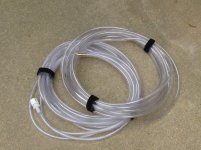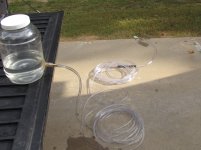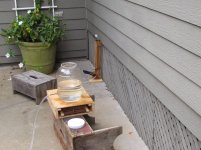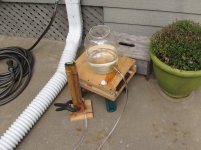ETpilot
Gold Member
I thought I would post this since there are lots of projects going on here where Level is important. I have two projects going now. One is I am preparing a site for a 20x20 storage/shed building. The other is a friends house, pier and beam, that is just a bit out of level.
There are lots of ways to find level. Line level, spirit level with long 2x4, transit and the laser level. For my projects I resort to the water level. It is an inexpensive way to find level. You can use it to level fence posts, check the lay of the land, set a drain pipe, check a foundation, check level of a house. There are numerous jobs where it can be used.
For my friends house I went in with the large bucket, 40' of tubing and the yardstick scale. I was able to find the high spot in the house and how it dropped out of level. I sketched the house and marked the amount of drop on the sketch.
In the pictures outside the house I am just taking a reading around the perimeter of the house just to see how the floor beams measured. I used 80' of tubing. It was just not enough. I could have used 20' more. Since the house had one wall that was level I was able to reposition my reservoir, find my zero mark and continue measuring.
There are basically 2 types of water level. One is the Bunyip. It is just tubing with water and 2 measuring sticks at the ends. This type requires 2 people to use. Since I generally work alone that type is out for me. So, I use the reservoir level. It consists of a water container, tubing and a measuring stick at the end. You can make it as simple or a fancy as you want. In my group picture I have the 2 water buckets, the 3 measuring sticks., I included the simple stick marked with measured lines just for illustration. I do not use that stick. I like to use the yardstick or ruler as it gives me precise measurements. The platform that the small bucket sits on is a lifting platform. It has a 10" lift so I can adjust the water level to suit the task at hand.
There are just a few rules for its use. One is get all the air out of the tubing when filling with water. Once you set your reservoir, do not move it as the readings will be off. Do not let any water drain out of the tubing or reservoir. Again the reading will be off. Do not let the middle of the tubing run get above the water level. You can go over obstacles and around corners
If you need to find level you may want to give the water level a try.
There are lots of ways to find level. Line level, spirit level with long 2x4, transit and the laser level. For my projects I resort to the water level. It is an inexpensive way to find level. You can use it to level fence posts, check the lay of the land, set a drain pipe, check a foundation, check level of a house. There are numerous jobs where it can be used.
For my friends house I went in with the large bucket, 40' of tubing and the yardstick scale. I was able to find the high spot in the house and how it dropped out of level. I sketched the house and marked the amount of drop on the sketch.
In the pictures outside the house I am just taking a reading around the perimeter of the house just to see how the floor beams measured. I used 80' of tubing. It was just not enough. I could have used 20' more. Since the house had one wall that was level I was able to reposition my reservoir, find my zero mark and continue measuring.
There are basically 2 types of water level. One is the Bunyip. It is just tubing with water and 2 measuring sticks at the ends. This type requires 2 people to use. Since I generally work alone that type is out for me. So, I use the reservoir level. It consists of a water container, tubing and a measuring stick at the end. You can make it as simple or a fancy as you want. In my group picture I have the 2 water buckets, the 3 measuring sticks., I included the simple stick marked with measured lines just for illustration. I do not use that stick. I like to use the yardstick or ruler as it gives me precise measurements. The platform that the small bucket sits on is a lifting platform. It has a 10" lift so I can adjust the water level to suit the task at hand.
There are just a few rules for its use. One is get all the air out of the tubing when filling with water. Once you set your reservoir, do not move it as the readings will be off. Do not let any water drain out of the tubing or reservoir. Again the reading will be off. Do not let the middle of the tubing run get above the water level. You can go over obstacles and around corners
If you need to find level you may want to give the water level a try.




